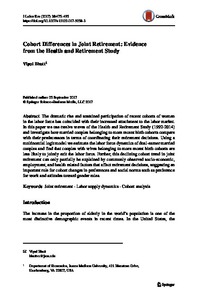Cohort differences in joint retirement: evidence from the health and retirement study

2017
38
4
December
475-495
retirement ; labour force participation ; women
Social protection - Old age benefits
https://doi.org/10.1007/s12122-017-9258-3
English
Bibliogr.
"The dramatic rise and sustained participation of recent cohorts of women in the labor force has coincided with their increased attachment to the labor market. In this paper we use twelve waves of the Health and Retirement Study (1992-2014) and investigate how married couples belonging to more recent birth cohorts compare with their predecessors in terms of coordinating their retirement decisions. Using a multinomial logit model we estimate the labor force dynamics of dual-earner married couples and find that couples with wives belonging to more recent birth cohorts are less likely to jointly exit the labor force. Further, this declining cohort trend in joint retirement can only partially be explained by commonly observed socio-economic, employment, and health related factors that affect retirement decisions, suggesting an important role for cohort changes in preferences and social norms such as preference for work and attitudes toward gender roles. "
Digital
The ETUI is co-funded by the European Union. Views and opinions expressed are however those of the author(s) only and do not necessarily reflect those of the European Union or the ETUI.